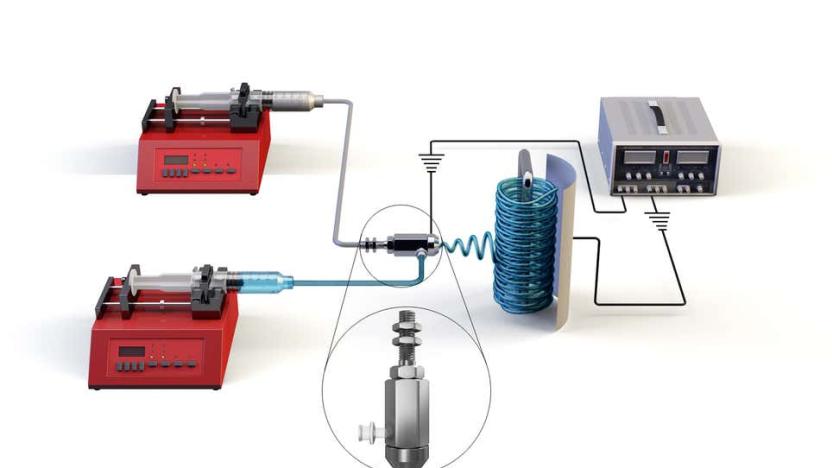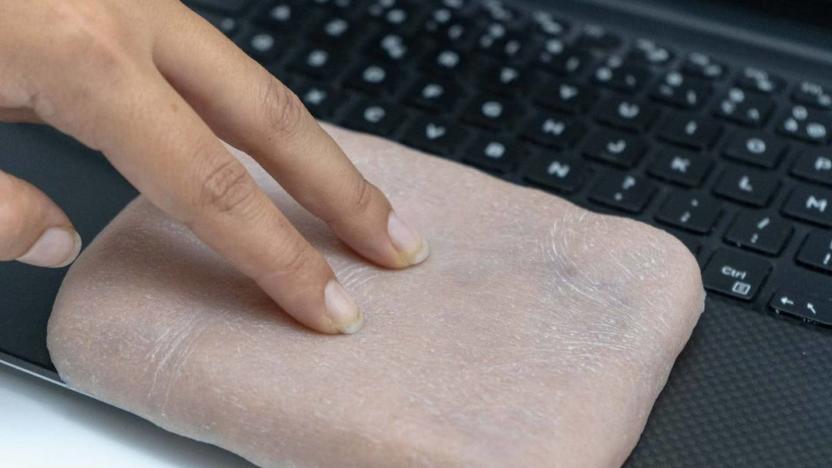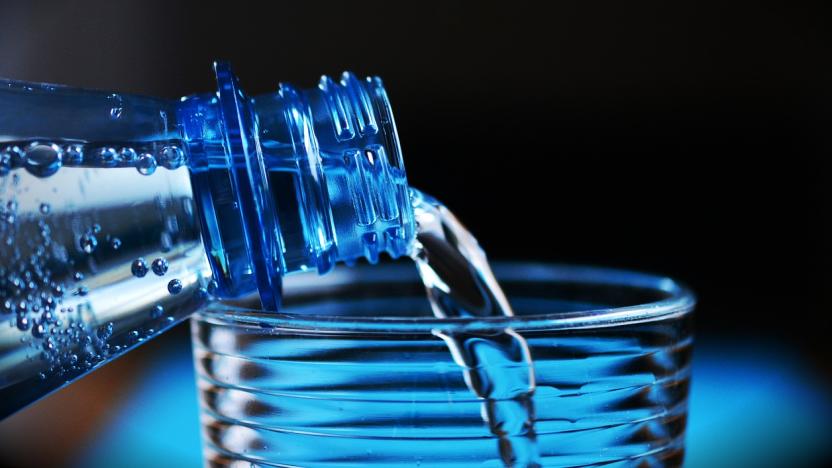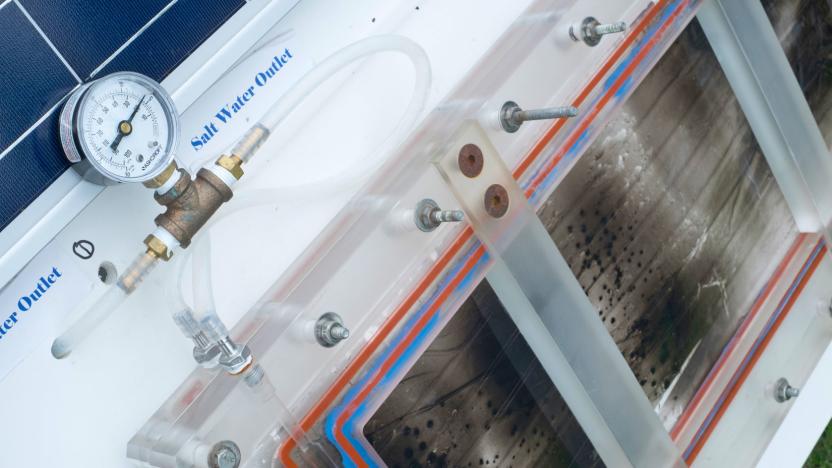membrane
Latest

A nanofiber membrane could help solve the drinking water crisis
Researchers from the Korea Institute of Civil Engineering and Building Technology have created a nanofiber membrane that can desalinate water for up to a month.

Researchers create an artificial skin that makes your phone ticklish
We're so reliant on our smartphones that it's probably fair to say they've become an extension of ourselves, so the fact that scientists have now developed an artificial "skin" for our devices -- that has the ability to make them ticklish -- is not a huge surprise. Horrifying, maybe, but it was only a matter of time.

Scientists create ultra-thin membrane that turns eyes into lasers
It will still be a while before scientists are able to harness Superman-like laser vision, but the technology is now closer than ever before thanks to a new development from the University of St Andrews. The team there have created an ultra-thin membrane laser using organic semiconductors, which is for the first time compatible with the requirements for safe operation in the human eye. Even though the membrane is super thin and flexible, it's durable, and will retain its optical properties even after several months spent attached to another object, such as a bank note or, more excitingly, a contact lens.

Rare metals could make hydrogen-powered cars more efficient
Despite being much faster to fuel up than EVs, hydrogen fuel cell-powered cars have largely failed to make an impact. There are various reasons for that like the crazy expensive infrastructure and hydrogen's explosiveness, but the main one is that from well to wheels, hydrogen cars are much less efficient than EVs. Now, researchers from Spain and Norway have unveiled a new method to convert methane to hydrogen with almost no loss of energy, perhaps making the vehicles (slightly) more feasible.

Scientists use molecular 'sieve' to purify water
Researchers have taken a major step forward in making previously undrinkable water drinkable, therefore tackling one of the biggest challenges faced by the planet -- some 1.2 billion people lack access to clean drinking water (a number which is set to grow as populations increase). By modifying graphene oxide membranes, the international team of researchers has created what is essentially a molecular "sieve". The selectively permeable membrane lets some molecules through while trapping others behind, producing water at various levels of cleanliness suitable for drinking or for industrial applications.

Researchers can now desalinate seawater with the power of the Sun
One of the oldest means of extracting potable liquid from seawater involves distillation, basically boiling the water into steam and then cooling the purified vapor in condensation tubes. Problem is, this method is incredibly power intensive with nearly half of the input energy going towards just boiling the water. But, a team of researchers from Rice University have developed a new technique that not only drastically reduces the amount of energy needed but can decouple the process from the power grid altogether.

Solar-powered machine turns urine into drinkable water
Scientists from a Belgian university have built a solar-powered machine that can turn urine into drinkable water. They deployed it at a 10-day music and theater festival in central Ghent, Belgium. The experiment was a success as the scientists were able to recover a 1,000 litres of unconsumed water, which will be used to make Belgian beer, from the urine of several partygoers.

Artificial cell membranes could lead to more effective drugs
Medical science often targets drugs at the proteins in cell membranes. But how do you study everything about their behavior when you can't control them? That's what UC San Diego researchers aim to fix. They've developed artificial cell membranes that grow and model themselves just like those in mammal cells, making them ideal for testing how drugs will behave. The trick is to use reversible chemical reactions that remodel phospholipids (key molecules in the cell membrane) and make the cell 'recycle' them, rather than generate them from scratch. That, in turn, saves the cell a lot of effort as its membrane grows.

DARPA tests ground-based prototype of its folding space telescope (video)
Researchers want higher-resolution images of the Earth from space, but glass-based telescopes won't always be up to the job; eventually, the necessary hardware will be too bulky to lift into orbit. It's a good thing, then, that DARPA recently tested a ground-based prototype of its MOIRE (Membrane Optical Imager for Real-Time Exploration) folding telescope. Like the future spaceborne unit, the ground telescope replaces glass with a high-efficiency polymer membrane that weighs one seventh as much and collapses into compact shapes. The optics would launch at a diameter of 20 feet, but they would expand to 68 feet. That's larger (and likely sharper) than what you'll see at many Earthbound observatories for quite some time. DARPA hasn't committed to a launch date for its folding design, but the finished device could image 40 percent of our world in one shot -- a major advantage for defense planners who may literally need to see the bigger picture.

Microbial fuel cell produces hydrogen from wastewater without wasting energy
Back in 2005, Bruce Logan and his team of Penn State researchers developed a microbial fuel cell capable of converting poop into power. Now, Logan has refined his system to the point where it can produce hydrogen from wastewater or biodegradable organic materials without using a drop of grid electricity, and without emitting even a hint of carbon dioxide. His approach, outlined in the September 19th issue of the Proceedings of the National Academy of Sciences, involves something known as reverse-electrodialysis (RED) -- a process that harvests energy from the ionic discrepancy between fresh and salt water. Logan's bacterial hydrolysis cell (pictured left) features a so-called RED stack that's comprised of alternating positive and negative ion exchange membranes, which it uses to split water molecules into hydrogen and oxygen. Normally, this process would involve about 25 pairs of membranes, but by using RED technology in conjunction with electricity-producing exoelectrogenic bacteria, Penn State's team was able to extract hydrogen with just five membrane pairs. All told, Logan's cells proved to be about 58 to 64 percent energy efficient, while producing between 0.8 to 1.6 cubic meters of hydrogen for every cubic meter of liquid that passed through the system. The researchers' results show that only one percent of that energy was used to pump water through the cells, which are completely carbon neutral, as well. According to Logan, this breakthrough demonstrates that "pure hydrogen gas can efficiently be produced from virtually limitless supplies of seawater and river water and biodegradable organic matter." Somewhere, the US Navy is taking scrupulous notes. Full PR after the break. [Image courtesy of Penn State / Bruce Logan]

Asius' ADEL earbud balloon promises to take some pressure off your poor eardrums
Listener fatigue: it's a condition that affects just about everyone who owns a pair of earbuds and one that myriad manufacturers have tried to mitigate with various configurations. According to researchers at Asius Technologies, though, the discomfort you experience after extended periods of earphone listening isn't caused by faulty design or excessively high volumes, but by "acoustic reflex." Every time you blast music through earbuds, your ear muscles strain to reduce sound waves by about 50 decibels, encouraging many audiophiles to crank up the volume to even higher, eardrum-rattling levels. To counteract this, Asius has developed something known as the Ambrose Diaphonic Ear Lens (ADEL) -- an inflatable polymer balloon that attaches to the ends of earbuds. According to Asius' Samuel Gido, the inflated ADEL effectively acts as a "second eardrum," absorbing sound and redirecting it away from the ear's most sensitive regions. No word yet on when ADEL may be available for commercial use, but head past the break for a video explanation of the technology, along with the full presser.

The OverAchiever: Insane in the Membrane
Most of you are excited for 3.1 so you can start raiding Ulduar, or take advantage of the new class changes. But I know what some of you are on pins and needles for. It's the new title The Insane. Insane In The Membrane is exactly what it sounds like -- an achievement for people who are completely nuts. To earn this title you must be willing to spend a lot of time destroying and raising obscure factions in Azeroth. I mean a lot of time. It requires that attain the following:Honored with Bloodsail Buccaneers Exalted with EverlookExalted with RatchetExalted with Booty BayExalted with GadgetzanExalted with RavenholdtExalted with Darkmoon FaireExalted with Shen'dralarYep. If you want to get started on this brain-breaking journey, just follow the jump.

iKey's Membrane keyboard is built for the nastiest of environments
iKey's done this whole rugged keyboard thing a time or two before, so when it builds one meant to operate like a champ around environments laden with grease, you know it means business. The new line of Membrane keyboards -- which arrives in a trio of flavors -- boasts a stainless steel enclosure, or customers looking to integrate can snag the OEM edition and do as they please. The board possesses a "hard-coated, textured, polyester film that is more rugged than industrial silicone rubber keypads," and it's designed to withstand "directed hose water, disinfectants and environmental contaminants." Seems as though you'll have to phone up iKey to find out what this Apocalypse-approved device will run you, but it should get along quite well with that impenetrable Iron Drive of yours.[Via Coolest-Gadgets]







